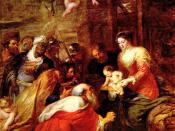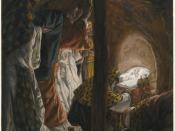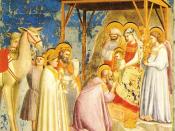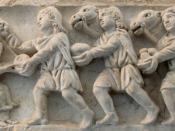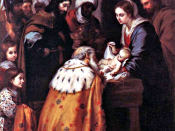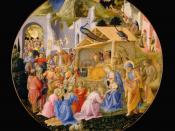The Adoration of the Magi One piece of art work, that I found to be beautiful was Bernard Van Orley's painting entitled, The Adoration of the Magi, from around the time of 1515. It contains a charming portrayal of Mary holding the baby Jesus, surrounded by the wise men and a crowd of people. The painting has a very peaceful setting, which adds to the wonderful feeling that portrayed though this it. This work of art immediately struck me as being both a magnificent and appealing painting.
Many people are familiar with the story of the Nativity scene where the Magi were led to Christ by the guiding angel. In Orley's painting, The Adoration of the Magi the nativity scene is the setting that is being presented to us. Mary sits with the baby Jesus naked on her lap. There is a group of people including the Magi, gathered around her and Christ, but they do not appear to me paying attention to her.
The three Magi are usually known as Caspar, Melchior, and Balthazar (Mannerings 44). Although the group of people and the Magi are facing the same direction as Mary, they are not interested her, they are admiring Jesus. Mary is simply the throne of the divine son. She is not participating in any interaction with the crowd or the kings; she is just looking down at her child. The relationship between the Magi and the blessed Child seems to be incredibly significant. It consists of genuine expressions of tenderness and exchanged looks. The three kings are facing the baby Jesus, adoring him. Magus presents him with a gift, kneels before him, and is kissing his feet. The kneeling action that is shown is thought of as an expression of piety and adoration. As Magus kisses his feet, Christ reaches his hands out, and places them upon Magus's head. This appears to be the act of Christ blessing him, as if in absolution.
By tradition, the gifts that the three kings brought are the vessels in which the gold, frankincense, and myrrh are offered. They can be shown in various liturgical vessels, but here we see them in three identical chalice like objects. The gift of the kneeling Magus is usually seen either held by Joseph, by a servant, or laid on the ground in front of the Child, which is what we see here.
In this painting the right side of the closest building forms a perfectly straight line that appears to be nearly the dead center of the picture. This line draws attention to Mary and the child who are centered in the piece of work, this emphasizes that these two figures have importance. The lines that are used help describe the shape and the space of the painting in a consistent and orderly way. The lines of the painting seem to pile up on one another, creating a kind of physical density and depth. As the lengths of the vertical lines become shorter, we see a great sense of depth. The buildings become smaller as they move back, and the main focus continues to be the commotion that is occurring in the front area of this painting.
This painting invokes the illusion of three dimensions by imitating the effects of light as it falls on three-dimensional surfaces. The gradual shifts from light to dark across the same surface indicate a rounded or contoured form. This picture ranges from dark blacks in its shaded areas, through shades of gray, to high lights of a very light, almost white gray. This technique of creating different surfaces by means of gradual shifts and gradations of light and dark also brings a good idea of depth and dimension into the artwork. The artist was able to manipulate contrasts of light and dark to create highly dramatic and emotional images.
This painting also displays a mixture of both analogous and complementary colors. There is an example of analogous colors with the kings reddish clothes against the yellow floor. It is also portrayed in the right corner of the painting, where the blues of the buildings and sky meet up with the green grass and plants. An example of a complementary color is shown by the person standing on the right side of the painting wearing reddish clothes, which is next to the green grass. The front central area of the painting consists of combinations of red, orange, and yellow which are warm colors. These warm colors bring a sense of love and calmness to the picture, while the blue, green, and violet in the background bring a little bit of a cooler feeling into the painting.
The Adoration of the Magi has profound historical and religious connection. It refers to the time when the wise men arrived in Jerusalem from the East. They inquired where they could find the child destine to be the king of the Jews. Recalling prophecies, King Herod directed them to Bethlehem, asking them to report back with the secret intention of eliminating a threat to his authority. The Magi followed the star to Bethlehem. Over the centuries the Gospel story was elaborated. In the Catholic West, the number of the magi was fixed to only three, and they were named as Caspar, Melchior, and Balthazar (Mannerings 44.) Artists took the opportunity to contrast the humble surroundings of the holy family with the rich apparel of the kings.
From the 4th century AD, when Christianity became supreme throughout the Roman world, skills and resources were increasingly devoted to religious art (Mannering 7). Then, after the collapse of the Roman Empire in the West, the authority and wealth of the Church ensured that this situation remained essentially unchanged for over a thousand years. The Renaissance gave secular works a new status, but only in the 18th century did the long supremacy of the religious art come to an end. Art, especially religious art has taken many forms, such as mosaic, stained glass and sculpture, and painting on manuscripts, panels, canvases and walls. It has also fulfilled many functions, providing picture texts for the illiterate, as well as beautiful objects and buildings. In time the buildings included homes of laymen. By the late Middle Ages, secular patronage was becoming increasingly important.
In the past most artists were told what subject to paint, and were expected to work in a set of widely accepted conventions. Later, religious and social changes made it possible for an artist to work in a personal style, and even develop a personal vision. The sense of history was a relatively late development, and many artists have shown biblical characters in different styles of clothing and settings like those of their own contemporaries, a practice which served in its time to make the event portrayed seem more vital and relevant (Male 44).
Much religious art is not directly drawn from the Bible. It includes legends, which have since grown up around biblical events, the post-biblical teachings of the churches, and the entire 2000 year old history of Christianity.
I feel that The Adoration of the Magi is a beautiful piece of artwork. I think that there is not only a beautiful peaceful setting in the painting, but you can see beauty through the connection that we see between the Christ and the kings as well as Christ and the townsmen. The feeling that the painting makes you feel composes an even more extravagant picture.
I feel that through this painting I was able to realize that there is both a beauty of art and a beauty of nature. Nature has a natural beauty to it, while in art one person may perceive a picture much differently than another person. Everyone has a varied perception of beauty, but through works of artists we are able to view different yet possibly familiar scenes that bring us to an understanding of what things are, such as beauty.
When I look at The Adoration of the Magi, I see a painting that is filled with beauty from nature. The nature effect makes the picture seem comfortable, familiar, and warm. I like the way the sunlight brightens up the picture and brings an uplifting feeling, which gives off such a positive effect. The warm yellowish glow that is sweeping across the picture is remarkable and appears to be so realistic and happy.
Another important beautiful aspect is the interaction between Christ and the group of people. When I first looked at the painting the first thing my eyes were drawn to was Mary, Christ, and Magus. The interaction that is taking place is absolutely amazing. There is such an incredible heartening experience going on here. The relationship between Mary and her Child seems very peaceful and soothing. They both appear very familiar and calm with each other and their surroundings. The connection that is going on between Magus and Christ is also pleasing. Magus seems so honored to be in his presence, along with every one else in the picture. I think it is inspiring to see the amount of respect that such a young person is getting. The energy that the baby Jesus is releasing is so powerful and at the same time comforting.
I think that by being able to appreciate the aesthetic values that are presented, we are able to encounter an aesthetic experience. Through our aesthetic experiences we are able to re-identify different incidents, and are able to understand why we treasure them. I feel that it is our sense of beauty and ugliness that makes our experience of certain objects so worthwhile. When we are able to appreciate art we are left with a sense of happiness and joy. I feel that if we look at a piece of artwork and then encounter an amazing feeling inside, then we are reminded of what counts. By looking at Bernard Van Orley's painting of The Adoration of the Magi, I was able to take part in a wonderful experience. This work was beautiful not only because of the physical beauty that was portrayed, but also the beauty that was captured in the scene of the painting.
Bibliography Clutton-Brock, A. Works of Art. New York: Books For Libraries Press, 1968.
Male, Emile. Religious Art. New York: Panttheon Books Inc., 1949.
Mannering, Douglas. Great Works of Biblical Art. Italy: Parragon Books Service, Limited, 1995.
Moore, Albert C. Iconography of Art. London: SCM Press Limited, 1977.
